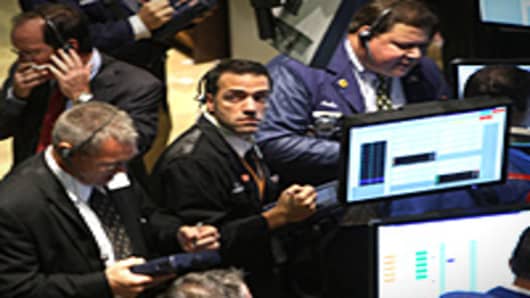Despite the riptide rides the market has taken over the past two weeks, investment pros aren’t running for the exits.
With the market down 15 percent in the past three weeks and 11 percent in August alone, the idea that the market is not in full panic mode could indicate that there is more—significantly more—room to the downside.
Evidence that the stock landslide hasn’t chased many investors to the sidelines comes from the Investors Intelligence survey, which checks newsletters from market pros across the country to see which way they are titling. It is one of the most-watched indicators of market sentiment.
According to the numbers through Tuesday, market bulls actually rose to 47.3 percent while the bears dropped to 23.7 percent. That is in contrast to last week’s margin of 46.3 percent to 24.7 percent in favor of those who think the market is going to rise.
In times of aggressive market selloffs there’s a need for capitulation—or the point when the final stragglers who don’t believe in the drop finally get out. That marks a turning point where the market can gain.
But with the Investors Intelligence spread far from normal levels associated with a bottom, that could spell trouble for the already-volatile market. The August 2010 bottom saw an even split between bulls and bears while the late 2008 bottom saw bears with a 30 percent advantage.
“Essentially, the survey implies equities are yet to reach a floor of significance and any near-term rally should be taken with a pinch of salt,” Tarquin Coe, of Investors Intelligence, said in an analysis accompanying the survey results.
The lack of a panic bottom trend is playing out elsewhere.
The exchange-traded fund market, with its varied products that allow investors to go both long and short on virtually every aspect of the market can tell an interesting—and sometimes contrarian—story about how investors feel.
During Monday’s huge market selloff, when the Dow industrials lost more than 600 points, traders poured $162 million of new capital into options-based products, with the bulk going to the iPath S&P 500 Short-Term CBOE Volatility Index fund.
But the bulk of the money wasn’t from people who believed volatility would increase, according to Nicholas Colas, chief market strategist at ConvergEx.
“The creations of these shares were not because investors wanted to bet on more volatility—it was because they actually wanted to short volatility,” Colas said in a note.
Such a move would be a bullish play, on the belief that volatility as measured by the various VIX products drops when the market rises.
As a short-term play, shorting volatility worked well on Tuesday but extremely poorly on Wednesday, when the market suffered through yet another steep selloff.
That’s behavior more typical of a market in which investors are relying on hope to propel the averages higher.
“The average money manager looks at 10 percent like, ‘We need a correction.’ We’re kind of in that range now. They’re not worried,” says Kathy Boyle, president of Chapin Hill Advisors in New York. “The hedge funds are scrambling, which is part of the pressure here.”
Boyle is generally bearish on the market but thinks a temporary bottom is in sight, with 1100 on the Standard & Poor’s 500 an important target. From there she sees a powerful rally but then an even bigger drop from there after investors get even more complacent.
“Once it rallies everyone thinks everything is just peachy again,” she says. “The sucker rally is what’s going to get people. Because then we’re going to implode from there.”
Questions? Comments? Email us at NetNet@cnbc.com
Follow Jeff @ twitter.com/JeffCoxCNBCcom
Follow NetNet on Twitter @ twitter.com/CNBCnetnet
Facebook us @ www.facebook.com/NetNetCNBC




